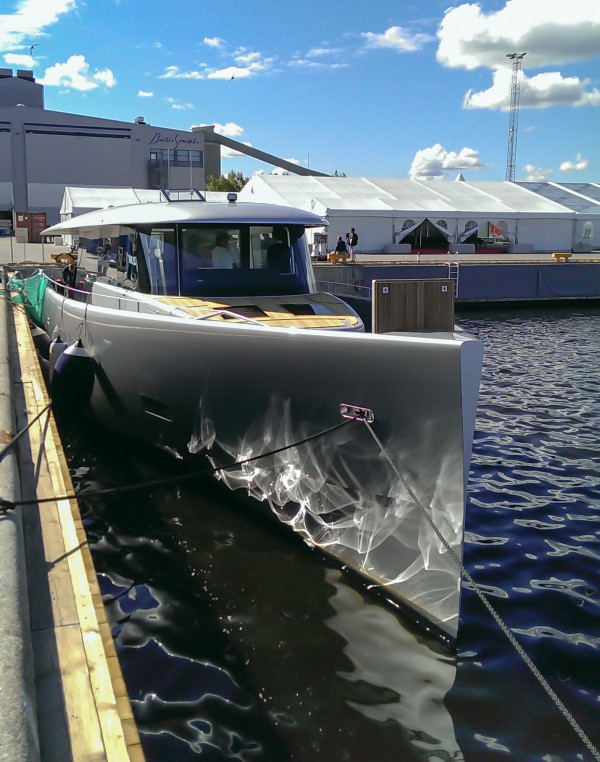Crossing boundaries between sail and power
Mani Frers talks to SuperyachtNews about the challenge of designing a motor yacht and how sail and power are influencing each other…
It’s a glorious summer morning at the Baltic Yachts yard in Finland, and the reflected sunlight is dancing off the hull of another yacht nearing delivery. This, however, is no ordinary Baltic – this is the futuristically styled 23.9m MY 78 power boat, commissioned by a client who wanted to enjoy quiet, efficient cruising at a wide range of speeds. It follows the announcement at the start of 2017 of Baltic’s move into the powerboat market, offering fully custom, carbon and composite motor yachts up to 60m in length.
The 23.9m yacht may be a departure from Baltic Yachts’ traditional sleek sailing machines, but many of the core principles remain – careful weight factoring, modern design and that expert carbon construction. The hull came from the boards of naval architect Germàn Mani Frers, and as we catch up with him on the dock it quickly becomes clear that there is more to this crossover than simply a sailing yacht builder venturing into powerboats.
Mani Frers is well known for designing sailing yacht hulls from custom projects to some of the world’s most popular production sailing yachts, so how was the experience of designing a motor yacht? “It was fantastic and challenging for me,” he begins. “You start with a clean sheet of paper, and I started by designing a hull that could go any speed and still be very efficient and seaworthy with nice movement. We worked a lot on the movement and the accelerations on board so it is both comfortable and has minimal noise.”
Key to this has been careful consideration of the superstructure roof. “We had ventilation and those elements going off the roof (to reduce noise further) and the roof is designed with a special shape,” Frers explains. “It is aesthetically pleasing but it also takes noise away from the area, and the faster you go, the more it sucks the air – and the noise – away.”
The client brief for this project was clear, and it was this that began to inform the initial design. “You start by considering how fast you want to go,” says Frers, “and what the client wanted was to be able to go 10 knots some days but with a maximum of 25 knots. So that set our parameters and showed the area we had to optimise. I’ve had this hull shape in mind for quite a while and it was a good opportunity to put it into practice.” The hull was tested using a scale, remote-controlled model that was put through its paces in storm conditions with very big waves, which proved the perfect testing ground for the theory. And it is a hull that shows where sailing yachts and motor yachts are starting to cross tacks, as it were.
“Doing a motor yacht forces you to look at new shapes, and funnily enough it makes the sailing boats better,” Frers enthuses, “because sailing boats have similar performance characteristics in that they can sail from, say, 15 knots to 22 kntos. So when you are thinking efficiency, seaworthiness, performance and seakeeping, all these things apply to both motor and sail. But with a powerboat you can choose which speed you want to go, whereas with a sailing boat that is less the case. So it’s very useful, and I think it has helped me to do better sailing boats.”
The hull of this Baltic, says Frers, is in fact more akin to a sailing yacht than a classic V-hull or displacement motor yacht, either of which comes with its own set of problems when you are trying to span the hump speed – the point at which a yacht switches from displacement to semi-displacement or planing modes. “This boat doesn’t change trim as you increase speed, and actually it has a very smooth curve,” Frers explains. “It’s more like a sailing boat in that sense.
“It was very pleasing,” he continues. “And then you learn from that, and when you’re designing a fast sailing boat you can apply some of the tricks you’ve learnt, because those sailing yachts are also moving from displacement speeds into semi-planing speeds.”
While Frers admits that there remain differences between motor and sail, the crossover reaches into more areas, including motion. In fact, he says, this is an area which generally is being considered far more deeply in modern design. “With this motor yacht I was very deep into motions and accelerations and how they make people feel on board,” he says. “In the past people would get seasick and it was often put down to them just not being very good sailors. But now we are designing superyachts with the motion for the best comfort, and that comes from the motor yachts side. We now apply that to the sailing superyachts and we are actually making those yachts not only faster but also more comfortable.”
This Baltic MY78 might not be the only incarnation of Frers’ crossbreed design philosophy, though. “The hull design scales really well,” he says, “and we have a 30m version designed already. In fact, the glass design comes from a 60m we did a few years ago, and for the hull actually the bigger the better – you could take it to 100m and the shape would work as efficiently. We are also doing a wooden, 7m electric-powered version of the hull for a Lake Como boat – it’s strong and beautiful and it will do 25 knots with no noise. It’s all changing the way we go boating."
While the bright and spacious interior of the MY78 model – created on the boards of Design Unlimited – is being finished, the yacht is expected to be delivered this summer and could well make an appearance at the Cannes boat show in September. She will be well worth a look, not only for her innovative styling and increased space thanks to that carbon construction, but also for her demonstration of how motor and sailboat design are beginning not only to inform each other, but to borrow from each other too.
Profile links
Frers Naval Architecture & Engineering
Click here to become part of The Superyacht Group community, and join us in our mission to make this industry accessible to all, and prosperous for the long-term. We are offering access to the superyacht industry’s most comprehensive and longstanding archive of business-critical information, as well as a comprehensive, real-time superyacht fleet database, for just £10 per month, because we are One Industry with One Mission. Sign up here.





